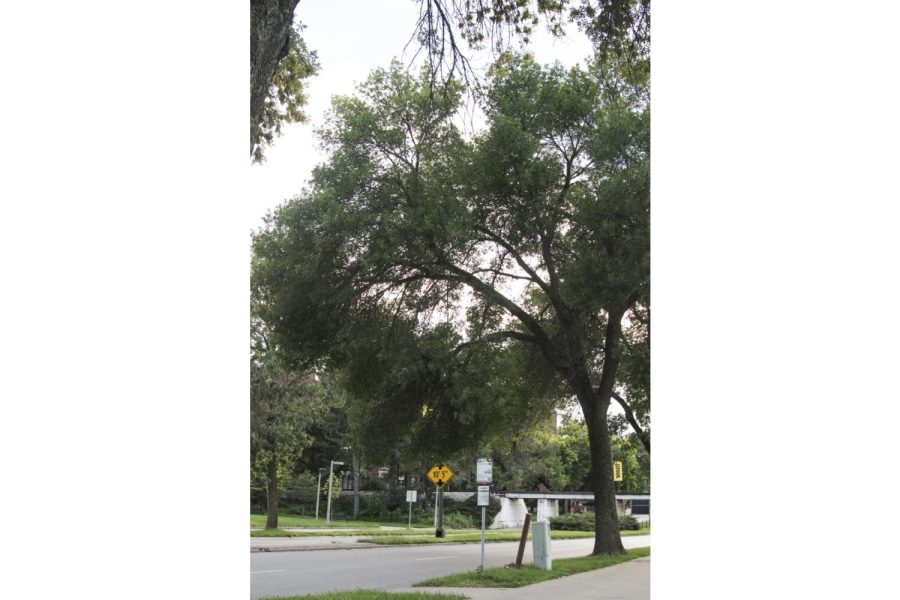Opinion | It’s time to start paying attention to the diversity of tree species on campus
After historical waves of invasive species infestations, UI campus responds to mass-killings of the Green Ash tree species by implementing an interesting kind of diversity: celebrity trees.
An emerald ash tree is seen on Iowa Avenue on Tuesday, Sept. 4, 2018. The City Council will be discussing the city’s current approach to Emerald Ash Borer and its impact on ash trees on public property.
February 21, 2022
Walking around campus, you might look at a tree and think nothing of it. Little do you know; you might be seeing saplings previously owned by world-renowned authors and poets.
While these famous trees instill pride and provide character to our campus, it’s imperative to remember our local vegetation’s history to learn from previous growing pains.
It’s time to recognize the problems that can arise from the lack of diverse tree species on campus.
As a result of massive loss of single tree species, UI arborists have prioritized the diversification of genus on campus through planting seedlings propagated from the properties of Edgar Allen Poe, Mark Twain, Henry David Thoreau, Alex Haley, Robert Frost, and William Faulkner.
As the harshness of winter slowly melts away and the first green buds of spring bloom, students will undoubtedly take to enjoying the green spaces tree canopies provide again.
From picnicking in the shade at the Pentacrest, protecting us from rain between classes, and strapping up hammocks or slacklines, campus trees are ingrained in our college experience.
However, the urban forests we interact with every day aren’t just background characters in the hustle-and-bustle of student life, rather they are silent keepers of local history and fascinating stories.
Yet, the survival of such stories hosted by Green Ash trees on campus are threatened by the invasive species, the Emerald Ash Borer.
Invasive species are non-native plants, animals, or pathogens that cause harm to any ecosystem they are introduced to.
The Emerald Ash Borer, a highly destructive species of beetle who migrated from north-eastern Asia in wood packing materials, lays its eggs in the bark of an ash tree. Once embedded, the larvae then slowly kill the tree through tunneling and suckling on its life source until it runs out.
These pests have wreaked havoc in the Iowa City community over the last decade, leaving over 700 dead ash trees in their wake.
Removing trees on campus deprives native species from their habitats, students from recreation, aesthetic appeals, and takes away the ecosystem benefits provided from trees.
However, this isn’t the first species of tree in Iowa City to undergo such devastation.
Believe it or not, the Green Ash were planted as replacements for a previous species, the Dutch Elm.
When the Dutch Elm disease swept through Iowa City throughout the 1960’s and 70’s, it took all but two trees with it.
University of Iowa’s Campus Arborist and Urban Forestry Supervisor Andrew Dahl called it an “ecological disaster to lose species of trees from the landscape,” when discussing past mistakes of relying on single species for tree coverage.
Through replanting primarily Green Ash after the Dutch Elm disease, the vicious cycle of relying on a single species continued and failed again in the future.
The monoculture of species and proximity of these trees essentially invited another wave of disease.
“When you have trees all of the same species, planted like a row of corn, and you lose one, it reminds me of a missing tooth in a smile,” Dahl said. “Even if you replace it, it will never be the same.”
Throughout his career, Dahl has prioritized planting diverse tree species on campus.
“The thinking is that the more diverse species you have, you don’t have all of your eggs in one basket,” Dahl said. “So, when a certain disease or insects comes by, you don’t lose them all again.”
Along with the 330 species he cares for on campus, Dahl has a passion for finding trees with historical significance and a good story.
“We’ve planted a literary clove at the Dey House,” Dahl said, reflecting on the planting of celebrity trees.
From trees of the iconic authors listed above to an actual apple tree from Johnny Appleseed, Dahl and his team have worked tirelessly to ensure not only a diversifying tree canopy, but star-studded saplings too.
“You might take a bite of that apple and think, ‘this tastes terrible,’ and then you think, ‘wow, this is actually from that tree. This is history,’” Dahl said.
Learning from past mistakes, Dahl hopes to one day see an assorted, lively urban forest with intriguing stories people want to come see and enjoy for themselves.
“Trees are one of the few things that will transcend generations of people,” Dahl said. “I hope that some of the trees I’m planting now will be enjoyed by hundreds of thousands of people in the future.”
However, Dahl hopes that one day, students will return in 20-30 years to come sit again under their favorite, healthy tree.
Columns reflect the opinions of the authors and are not necessarily those of the Editorial Board, The Daily Iowan, or other organizations in which the author may be involved.



